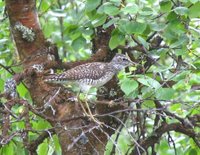Saturday, July 22, 2006
Liron kanta nousussa - Wood sandpiper (Tringa glareola) becoming more common
 Liro (Tringa glareola) on Värriön luonnonpuiston yleisin kahlaaja. Sen tapaa pienillä soilla (kuten kuvan yksilö Nuorttiahon jängällä), joiden laiteilla se voi nousta puuhunkin.
Liro (Tringa glareola) on Värriön luonnonpuiston yleisin kahlaaja. Sen tapaa pienillä soilla (kuten kuvan yksilö Nuorttiahon jängällä), joiden laiteilla se voi nousta puuhunkin.Värriön luonnonpuiston lirokanta on selvässä nousussa. Kolmella alkukesän pistelaskentareiteillä liron tapasi 1980 - luvun loppupuolella luvun keskimäärin vain pari kertaa. 2000-luvun puolivälissä liro lasketaan reiteillä yhteensä noin 10 kertaa.

Lirokannan nousu on tilastotieteen puolesta merkitsevä; nousun todennäköisyystaso on yli 99 prosenttia.
Wood sandpiper (Tringa glareola) is the most common wader in Varrio Nature Reserve. It is commonly seen in small swamps, peatbogs and aapamires of the reserve, like the one in the photo in Nuorttiahonjanka - swamp. In the wooded peatbogs the wood sandpiper does not hesitate to rest in the trees.
The stock of Wood sandpiper in Varrio is in steady rise. Based on the annual, spotwise line counts 1985-2006 this wader was met in the late 1980s on average only twice per year. Latest observations tell that it is observed altogether about 10 times per year. The rise of Wood sandpiper stock is also significant by statistical means; the probability level for the rise is over 99 per cent.